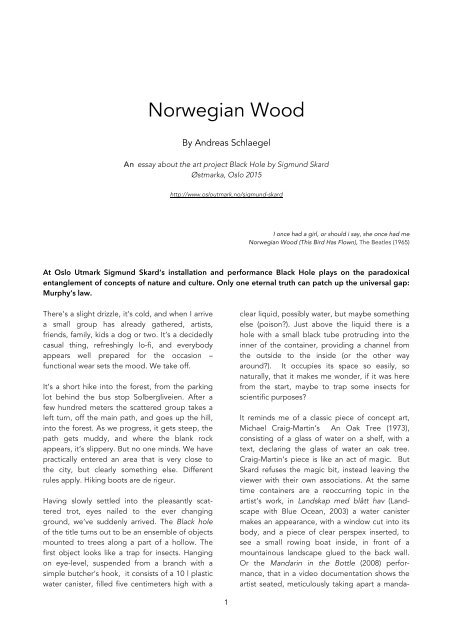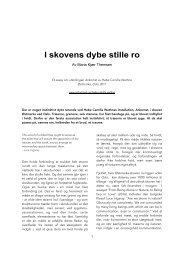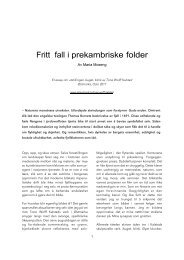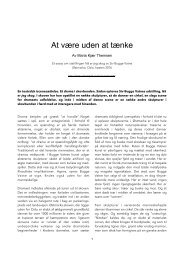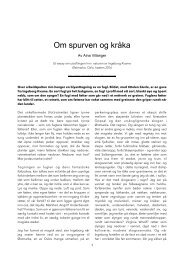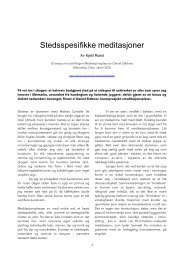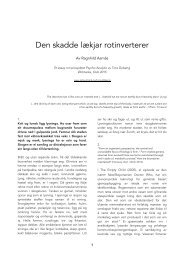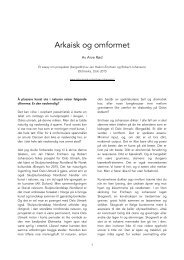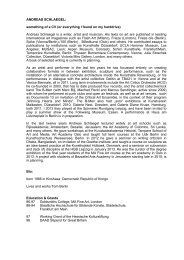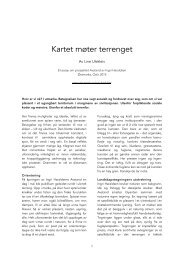Norwegian Wood
An essay by Andreas Schlaegel about the art project Black Hole by Sigmund Skard. Østmarka, Oslo 2015. http://www.osloutmark.no/sigmund-skard
An essay by Andreas Schlaegel about the art project Black Hole by Sigmund Skard. Østmarka, Oslo 2015. http://www.osloutmark.no/sigmund-skard
You also want an ePaper? Increase the reach of your titles
YUMPU automatically turns print PDFs into web optimized ePapers that Google loves.
<strong>Norwegian</strong> <strong>Wood</strong><br />
By Andreas Schlaegel<br />
An essay about the art project Black Hole by Sigmund Skard<br />
Østmarka, Oslo 2015<br />
http://www.osloutmark.no/sigmund-skard<br />
I once had a girl, or should i say, she once had me<br />
<strong>Norwegian</strong> <strong>Wood</strong> (This Bird Has Flown), The Beatles (1965)<br />
At Oslo Utmark Sigmund Skard‘s installation and performance Black Hole plays on the paradoxical<br />
entanglement of concepts of nature and culture. Only one eternal truth can patch up the universal gap:<br />
Murphy‘s law.<br />
There‘s a slight drizzle, it‘s cold, and when I arrive<br />
a small group has already gathered, artists,<br />
friends, family, kids a dog or two. It‘s a decidedly<br />
casual thing, refreshingly lo-fi, and everybody<br />
appears well prepared for the occasion –<br />
functional wear sets the mood. We take off.<br />
It‘s a short hike into the forest, from the parking<br />
lot behind the bus stop Solbergliveien. After a<br />
few hundred meters the scattered group takes a<br />
left turn, off the main path, and goes up the hill,<br />
into the forest. As we progress, it gets steep, the<br />
path gets muddy, and where the blank rock<br />
appears, it‘s slippery. But no one minds. We have<br />
practically entered an area that is very close to<br />
the city, but clearly something else. Different<br />
rules apply. Hiking boots are de rigeur.<br />
Having slowly settled into the pleasantly scattered<br />
trot, eyes nailed to the ever changing<br />
ground, we‘ve suddenly arrived. The Black hole<br />
of the title turns out to be an ensemble of objects<br />
mounted to trees along a part of a hollow. The<br />
first object looks like a trap for insects. Hanging<br />
on eye-level, suspended from a branch with a<br />
simple butcher‘s hook, it consists of a 10 l plastic<br />
water canister, filled five centimeters high with a<br />
clear liquid, possibly water, but maybe something<br />
else (poison?). Just above the liquid there is a<br />
hole with a small black tube protruding into the<br />
inner of the container, providing a channel from<br />
the outside to the inside (or the other way<br />
around?). It occupies its space so easily, so<br />
naturally, that it makes me wonder, if it was here<br />
from the start, maybe to trap some insects for<br />
scientific purposes?<br />
It reminds me of a classic piece of concept art,<br />
Michael Craig-Martin‘s An Oak Tree (1973),<br />
consisting of a glass of water on a shelf, with a<br />
text, declaring the glass of water an oak tree.<br />
Craig-Martin‘s piece is like an act of magic. But<br />
Skard refuses the magic bit, instead leaving the<br />
viewer with their own associations. At the same<br />
time containers are a reoccurring topic in the<br />
artist‘s work, in Landskap med blått hav (Landscape<br />
with Blue Ocean, 2003) a water canister<br />
makes an appearance, with a window cut into its<br />
body, and a piece of clear perspex inserted, to<br />
see a small rowing boat inside, in front of a<br />
mountainous landscape glued to the back wall.<br />
Or the Mandarin in the Bottle (2008) performance,<br />
that in a video documentation shows the<br />
artist seated, meticulously taking apart a manda-<br />
1
in and reassembling it inside a bottle, like ship in<br />
a bottle. With this in mind, I have the feeling the<br />
ship or the mandarin may have simply escaped.<br />
Maybe the black hole of the plastic tube offers<br />
freedom from the container. I wonder, am I really<br />
outside looking in?<br />
Another piece is even more laconic, consisting<br />
only of a string of tea bags hanging from a tree,<br />
like some kind of decoration, or spiritual offering<br />
to the tree Surprisingly, they are hardly affected<br />
by the rain, when we look at them. The sculptural<br />
gesture of this piece is so light, the intervention<br />
hardly even registers, even more than the<br />
canister, its simply a displaced product from a<br />
home or the supermarket ten minutes down the<br />
road. But then it‘s a cultural plant in its dried form<br />
that may have been grown in India, or at some<br />
other exotic location, and is transformed here<br />
into a dangling, a necklace, or simply, in a<br />
coproduction of global scale, producing droplets<br />
of cold tea, with <strong>Norwegian</strong> Rain, for no one in<br />
particular, or for anyone passing by. By the time<br />
of writing this I wonder if the piece survived so<br />
far. I‘m curious to what will happen to it, precisely<br />
because it is so ephemeral. It happens in the<br />
head more than in reality. But what reality is this<br />
anyway?<br />
While the first two pieces could be understood as<br />
having been placed nearly by accident, coincidence,<br />
serendipity or happenstance, the other<br />
two of his objects are placed in custom designed<br />
- for lack of a better expression - vitrines, leaving<br />
no question to their relationship to the site. Even<br />
if the individual pieces have about the sizes of<br />
birdhouses, they are decidedly alien to the<br />
location, made of perspex and wood painted in<br />
glossy enamel paint. Rather the opposite is the<br />
case, it‘s as if the site posed questions to them.<br />
The first is a slightly underwhelming one-liner: a<br />
roll of toilet paper in a holder, placed in a little<br />
wooden box, with a perspex front. The bottom of<br />
the box is open, making the toilet paper accessible,<br />
as if inviting the passersby to take advantage<br />
of it. The paper is funneled through a small<br />
wooden frame, turning the embossed floral<br />
patterns on it into an image, that contrasts with<br />
the raw vegetation of the surrounding. More<br />
irritating is the idea of the use of the toilet paper<br />
– and the contrast to the forest, or in other words,<br />
the clash of concepts of pristinely preserved<br />
nature and, well - human nature. Legendary<br />
2<br />
anarchic TV comedian Lenny Bruce once summed<br />
up the moment of the birth of civilization.<br />
According to him it was when one stone age<br />
person said to another: don‘t shit where you eat,<br />
my friend! Well put.<br />
As this is being written I have seen photographs<br />
taken of a wasp taking over the piece, starting to<br />
build a nest. I don‘t know if the wasp can use the<br />
toilet paper to create the elaborate paper-like<br />
structure of its nest, but it shows, that in this<br />
space, shared by so many different forms of life,<br />
the piece could operate in a completely unexpected<br />
way, and be it, a nesting place for wasps.<br />
Wasps as such are also a nice comment on the<br />
concept of Arcadia, the place where one can live<br />
in peace and beauty. Again it is a work with<br />
relatives in some of the artist‘s previous objects:<br />
there‘s a piece, where the artist ran his old belt<br />
through a similar small wooden frame, presenting<br />
the signs of wear, the widened holes and the idea<br />
of the artist slimming down or growing bigger as<br />
an image. Or another one, literally called Oneliner<br />
(2014), with a small roll of paper and a<br />
pencil, and the option to draw one continuous<br />
line, in homage to Piero Manzoni and his legendary<br />
Linee (1960) drawings made with a pen<br />
mounted to a rotating roll of paper, creating lines<br />
of a length of up to 7,2 km. Once again, Sigmund<br />
Skard shows a very clear understanding of scale,<br />
and a valuable sense of understatement, that<br />
opens a different can of worms. If Manzoni was<br />
obsessed with the hybris and myth of the artist<br />
genius, Skard‘s little frame captures, in the artist‘s<br />
words, „a tiny fragment of infinity.“<br />
The same goes for maybe the most enigmatic<br />
piece in this presentation, a box of perspex<br />
containing a stack of three spools of black<br />
insulating tape. Running through a hole at the<br />
bottom, the tape emerges at the other end,<br />
dangling outside the box, only to be jumbled up<br />
in three loose black balls. It looks as if the vitrine<br />
had testicles. Bruce Nauman comes to mind, an<br />
early video piece showing a close-up of the artist<br />
applying black paint to his testicles, in unnerving<br />
slow motion. Nauman, with his works brimming<br />
with ethereal Beckettian nonsense, or existential<br />
too-much-sense is one of the artists that may<br />
have served as source of inspiration for Sigmund<br />
Skard. Then again, he always manages to steer<br />
away from pure spectacle, keeping it real, with a<br />
healthy dose of everyday banality. Here it
appears to be a model for a black hole, and the<br />
progression through it, turning the order of things<br />
on its head and objects into anti-matter upon<br />
entry at the point of event horizon. Or science has<br />
us believe.<br />
But what attracts most of the attention is the<br />
centerpiece. Today, and only today, it‘s ready for<br />
performance. Set between two trees, the hollow<br />
it nestles into, between the mountain and a ridge,<br />
provides a natural theatrical background. The<br />
artist prepared bright orange lines between the<br />
trees, spanning over and past a large pile of<br />
roughly rectangular wooden blocks, which had<br />
been sculpted from fallen trees collected in the<br />
area. Arranged to a pile, as if waiting to be<br />
chucked into a fire, they laid there, half submerged<br />
in a big black puddle of unclear depth.<br />
The puddle accumulated only that day, when the<br />
artist arrived the stack had been sitting comfortably<br />
in green moss, from one day to the next it<br />
appeared to have been swallowed up by a<br />
swamp.<br />
Enter the artist, clad head to toe in elegant and<br />
decidedly urban black, Skard climbed onto the<br />
slacklines, like a trapeze artist. But far from the<br />
elegance of scantily clad circus ladies, he moved<br />
along with a comical, exaggerated style of<br />
walking, to balance on the elastic lines. This way<br />
he moved back and forth between a smaller<br />
second pile of wooden blocks, this one orderly<br />
stacked on one side, and a plastic sack of earth<br />
attached to the opposite tree on the other side.<br />
Taking a handful of the earth, he approached the<br />
pile, and, hovering over it, spread the earth on<br />
the top block of the pile, as if it was cement. Then<br />
he went to the orderly stored blocks, took one,<br />
turned around, and set it carefully on the spread<br />
earth on the pile. Once the blocks had grown to a<br />
small stack of four or five blocks, it collapsed,<br />
causing a little commotion in the pile, to a<br />
deadpan expression of the mute artist. His<br />
deadpan and muteness connects the persona he<br />
presents as a relative also of early slapstick<br />
comedians, like Harold Lloyd or Buster Keaton,<br />
the man who never laughed. Much like the work<br />
of these silent film era actors, who were trained as<br />
stage artists and of unique physical fitness,<br />
Skard‘s performance is not quite as dangerous<br />
but still an intensely physical one,. His body and<br />
posture plays an as important role, as his expression.<br />
There is a sense of continuity there, to the<br />
3<br />
performances of artists like Marina Abramovic or<br />
Roi Vaara.<br />
But what sets him apart from their approach is not<br />
only a sense of humor, but also one of humility,<br />
that makes his work hardly imposing and keeps<br />
pathos at bay. A clear indication of this quality is<br />
on display here. The small kids in the audience<br />
are mesmerized, by the grown up and his futile<br />
attempts at making use of his building blocks.<br />
They recognize not only the toy, the action, they<br />
also recognize the Mr. Bean-like character, and<br />
themselves in it - probably in much the same way<br />
as adults read the metaphors of the enactment of<br />
this balancing act of making ends meet and<br />
building things up.<br />
The difference is that much of Skard‘s work is<br />
imbued with tragedy: trial and failure are reappearing<br />
characteristics. Yet unlike the endurance<br />
works of Tehching Hiseh, for example, whose<br />
extreme performances last for a whole year (living<br />
outdoors in New York City for a year, or punching<br />
a punchcard every single hour every day for a<br />
year) the existential quality of Skard‘s lies on a<br />
metaphorical level, it remains theatrical. He uses<br />
props, and the displayed objects have this proplike<br />
quality, they are themselves banal, made of<br />
cheap, recognizably everyday materials, assembled<br />
in a way, that shows no apparent skill as<br />
such, but it‘s still about the meaning. In this,<br />
these pieces function a lot like poetry. The words<br />
are readily available, anyone can write poems. In<br />
this piece it could be seen as if Skard was<br />
attempting to rebuild or even to grow a tree. He<br />
uses the right materials - earth and parts of trees,<br />
all originally found in nature, but both used here<br />
at odds with it. The wood is rectangular and the<br />
earth is pre-packed in a plastic sack. But that‘s<br />
not the reason the tree-building fails - like a<br />
poem, it‘s a matter of composition. The paradox<br />
that Skard presents is the failed composition<br />
delivering a compelling piece of art. If we<br />
continue the idea of building the tree in our<br />
head, and the stack had grown to a height that<br />
could have competed with the other trees, it still<br />
would never be a tree.<br />
So what is it? It‘s exactly the opposite of Michael<br />
Craig Martin‘s oak tree, it‘s a black hole! And not<br />
the dark puddle, but the result of all this artistic<br />
performative activity. We could exaggerate, and<br />
say it amounts to nothing - except the traces of
someone having tried and failed. But, oddly, the<br />
sense of defeatism, that permeated the atmosphere<br />
of this piece, was oddly reassuring. If all is<br />
doomed anyway, there‘s nothing wrong with<br />
failing.<br />
In an earlier video piece, the artist, seen from his<br />
chin down, can be seen sitting at a table, with a<br />
candle stump. Lighting it, he takes another candle<br />
stump, putting out the first one with it, and<br />
sticking it on top, repeating this with several<br />
candle stumps, until the candle stack reached the<br />
height of his mouth. Then he blew it out. Would<br />
the candle have burned all the way down? Or just<br />
burned for the length of one stump? Does it<br />
matter? With the motif, the idea is already<br />
implanted in the viewers‘ imaginations, now it‘s<br />
up to us.<br />
In the forest, the performance continued, until all<br />
wooden blocks had become part of the big pile,<br />
a tiny stack, maybe three blocks high remaining,<br />
and the performance was over. Sigmund Skard<br />
changed back into his regular clothes and into his<br />
familiar self, nowhere near the austere and<br />
essentially mute artist persona adopted in many<br />
of his performance works.<br />
The next day he took down the lines, and<br />
removed all traces of his presence, except for the<br />
earth and the wooden blocks in the puddle, that<br />
remained as an odd sculpture. „Does it look like<br />
someone attempted to build something here?,“<br />
he asked. It took a small reconfiguration of the<br />
blocks to make it really clear that this was more<br />
than just a pile, rather a failed stack. With all other<br />
traces of the work removed, the pile and the<br />
stack emerging from it, had, in spite of their size,<br />
had turned into only a small, even humble<br />
sculptural intervention into the landscape. As<br />
nature will run its course, the wooden blocks will<br />
probably decay, and eventually fade into the<br />
landscape completely, in effect continuing the<br />
process of decay, the trees had entered, since<br />
they were felled. Many of them had already been<br />
rotten from the start.<br />
When Skard cut them into shape, the artist<br />
observed many being full of fat white larvae. „So<br />
much protein - I could imagine being a woodpecker.“<br />
<strong>Wood</strong>peckers could be regarded as a<br />
symbolic animal for Sigmund Skard‘s work. A bird<br />
that flies, builds nests and behaves perfectly like<br />
4<br />
birds do, except for sometimes, when it smashes<br />
its little head against trees. What looks like an<br />
absurd attempt at self-annihilation magically<br />
leads to the emergence of food, and life goes on.<br />
That the birds survive this radical specialization,<br />
that they don‘t damage their brains, that their<br />
brains and skulls have adopted to this bizarre<br />
behavior, however, is next to nothing in relation<br />
to the way civilization has affected the way<br />
humans live -the human condition. I look at<br />
screens and miraculously food appears. Sometimes<br />
at least.<br />
Repetition is a powerful tool, things get stronger,<br />
on many levels. Some become less unusual, even<br />
ritualistic, predictable. Something starting out as<br />
alienating will eventually turn into something<br />
reassuring, maybe even in spite of itself. The<br />
repetitions in everyday life, the technoid beat of<br />
daily routine, are reflected in the artist’s use of<br />
repetition as an artistic means, to build up power,<br />
like waves, like increasing momentum. The<br />
symbolism becomes a forced one, anything but<br />
effortless. Yet still sometimes their remarkable<br />
simplicity carries surprising power. Skard calls this<br />
strategy „amplifying“ and tells me that many<br />
works are based on taking objects and actions<br />
from the everyday, and subjecting them to this<br />
process of amplification until they start to, as the<br />
artist puts it, „come into focus, become important,<br />
become...something!“<br />
This something can be very little, and nonetheless<br />
create very powerful imagery. As when the artist<br />
uses his own body as a container to transport air<br />
from one end of the room to another, for example,<br />
by inhaling under a chair and exhaling in the<br />
far opposite corner of the room. There is no clear<br />
end to this performance, rather the artist decides<br />
when an end is appropriate. The performance<br />
Moving Air hovers between lightness – its subject<br />
is invisible, the way Skard moves through the<br />
space is deliberately casual - and heavy symbolism,<br />
with associations ranging from the very first<br />
to the last breath, and to expiration and inspiration.<br />
Even if the lightness wins, it still feels strange<br />
to walk through a room of displaced air, it‘s not<br />
nothing. It reminds me of being alive. It‘s a good<br />
experience.<br />
On our way home I wonder, when the concept of<br />
nature changed from that of an unchangable<br />
essence to that of an authentic, untampered-with
landscape. Probably it coincided with the<br />
invention of the autonomous artwork, in the<br />
Netherlands in the early 17th century. It all<br />
makes perfect sense.<br />
Suddenly, with the noise of breaking twigs and<br />
the rustle of leaves, a man on a mountain bike<br />
breaks through the bushes, comes to halt, and<br />
under his breath implores, where am I? Where am<br />
I?<br />
I don‘t know. It turns out, he lost his race. Not<br />
that he came in last, but he got lost. Sadly we<br />
can‘t help him. We can‘t help the character in<br />
Sigmund Skard‘s performances either. But we can<br />
say thank you. Thank you.<br />
Andreas Schlaegel has for nearly ten years now been trying to keep an eye on the <strong>Norwegian</strong> art scene from<br />
the perspective of an outsider. Educated at Städelschule, Frankfurt/Main and Goldsmiths College, London,<br />
he is an artist, writer and curator based in Berlin, and has focused on exploring the potential of collaborative<br />
formats between sculpture, performance and exhibitions. This practice also informs his teaching, as at the<br />
Oslo art academy KhiO, where he curated, the degree show of the MA program in 2013 at Kunstnernes Hus.<br />
His criticism and essays are published regularly by international art magazines, such as Frieze, Flash Art,<br />
Spike and Billedkunst, and many others, as well as in publications by art institutions such as Kunsthalle<br />
Düsseldorf; UCLA Hammer Museum, Los Angeles; MUSAC, Leon; Aspen Museum, Colorado; Schirn Kunsthalle,<br />
Frankfurt/Main; Thyssen Bornemisza Contemporary, Vienna, and many others.<br />
Sigmund Skard (b. 1952, Sveio, Norway) works in the grey area between art and reality. New forms and<br />
qualities of known and everyday material are used as basis for minimalistic and low-key works of art –<br />
performance, sculpture, object, photo, video, land art. The aesthetics and use of materials can be associated<br />
to the Fluxus movement and Arte Povera; spartan, absurd, playful and down to earth. Expression and<br />
themes are sober and pragmatic, with roots in country traditions and taoism. Skard has studied at the<br />
Academy of Art in Oslo (KHIO) and exhibited or performed at places like Kunstnerforbundet in Oslo, Örebro<br />
Art Hall, Kunstbanken Art Centre (Hamar), Gallery BOA, The Armory Show (NY), Sogn og Fjordane Art<br />
Museum, Vestlandsutstillingen, Gallery No Place. www.sigmundskard.com<br />
Oslo Utmark is one of Art in Oslo´s 17 temporary art projects in 2014/15<br />
Supported by Oslo Municipality and Arts Council Norway<br />
5


